

Information Technology (IT) Pioneers
Retirees and former employees of Unisys, Lockheed Martin, and their heritage companies
24-bit Computers, Chapter 51
1. Introduction:
Our 24-bit computer genealogy [below] is extracted from the Legacy genealogy charts and inserted below. Magnetic drum memories, a very important early ERA product, were designed to be used with the relay and vacuum tube machines that were being built for crypto-analysis by the National Security Agency predecessor.
Thanks to George Gray and Harry Wise for their recollections about the
machines of this early era. [lab]
A review of documents on the Bit Savers web site revealed some 24-bit CONUS processor descriptions. As I read them, my educated guess is that these were predecessors to the commercial 9200/9300 computers thus are referenced on chapter 59.
We welcome any reader additions to this part of our history.
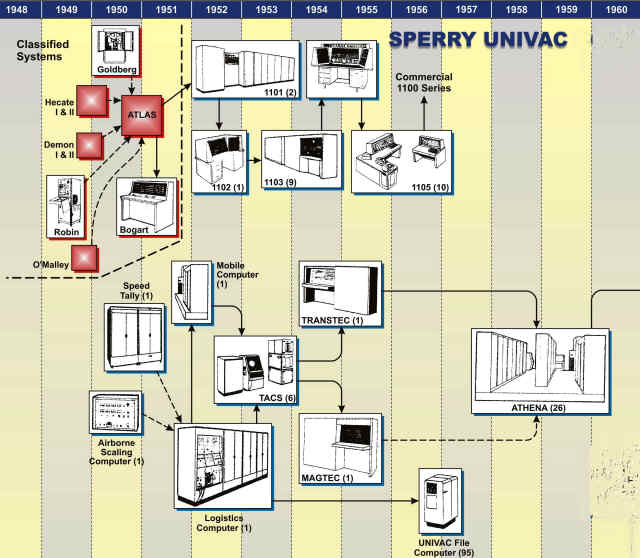 2. Genealogy Chart
2. Genealogy Chart
This chart, extracted from the larger chart, shows the first decade of computers. Most of them are further described below.
3. Computer summaries
3.1 Classified:
In the late 40s, ERA created several 'analytical machines' for the National Security Agency's predecessor. The Hecate I & II, the Demon I & II, the O'Malley, the Robin, and Goldberg were 24-bit analytical machines with plug board control and with drum memories to hold data during processing.
The Bogart [NSAgency] computer had 4,096 words of core memory supplementing its drum memory. {told to LABenson by Don Weidenbach}
3.2 ATLAS
Although shipped from St. Paul in late October 1950 by boxcar, the existence of this computer was classified until the mid 70s. Installation engineer Jack Hill once told the 1st Friday lunch group that he and Mullaney went home for Thanksgiving then returned to finish the installation. It was accepted by the 'CSAW' organization as operational in mid-December. See tech paper delivered at the same time.
3.3 1101 and 1102:
The beginning of the 1100 Commercial series which continues today.
By George Gray - The 1101 that ended up at Tahoma Technical Institute had been installed in Arlington, VA where Remington Rand set up a service bureau with the idea of renting time on it. The proposal for this originated with Howard Engstrom in March 1952. The 1101 there only became fully operational in February 1954. It was estimated that it would cost $150,000 to operate for a year while projected revenues would be no more than $100,000. In June 1954 it was decided to shut down the 1101 operation by October 1954. It was received at Georgia Tech in November 1954 but had to be put into storage until the building was ready the following summer. Installation of the 1101 began on August 4, 1955 and it was in operation three weeks later.
By Harry Wise - The first computer that I ever had anything to do
with was the ERA 1101 at Georgia Tech about 1955. ERA built one 1101
on “speculation” to sell into the commercial market. When
they were unable to sell it, Dr. I.E. Perlin from Ga. Tech talked Douglas
MacArthur into giving the machine to Tech. Dr. Perlin had a check for
$1,000,000 in his pocket to start a computer department. Tech got to
spend the all money on a really nice building, etc. The
1101 computer used a 24 bit word length mapped onto a rotating drum
main memory. The drum technology was invented by ERA engineers. The
architecture concepts evolved from the classified hardware project ATLAS.
Only two 1101s were built, plus a variation labeled the 1102.
The year before the first UNIVAC was installed, ERA had delivered
the first 1101 to Fort Meade. It weighed 17,000 lbs. It took ERA 9 days
to uncrate, install, and get the machine running. That included a huge
air conditioning set and a 100 hp motor-alternator set. It came up running
the program that was loaded in the drum memory in St. Paul before it
was torn down for shipment. I understand that the customer took over
the machine and put it straight into production the day it ran.
Note that the 1104 isn't missing, it was a 30-bit variation of the 1103A, thus is on the 30-bit computer pages.
3.4 Athena (U1463)
The Transtec and Magtec laboratory based computers implemented the same basic instruction set architecture in two different technologies. The transistor based model was used for the Athena. This ISA was different from the drum based ISA, it used a 16-bit instruction with a 24 bit data word. Twenty-six systems were delivered. The Athena computers had over 400 launches without an abort due to the computer or software. A web site with Athena follow on as a teaching/learning computer is at http://www.silogic.com/Athena/Athena.html, Thanks to Mark DiVecchio. [lab]
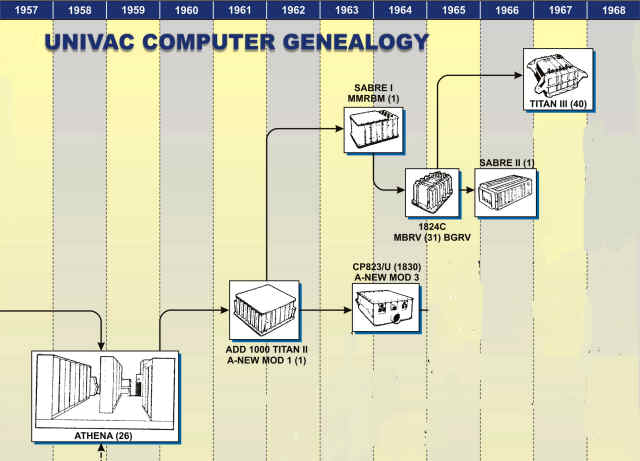 3.5 Spaceborne processors:
3.5 Spaceborne processors:
Titan II & III, Sabre I & II - No Legacy articles written these yet.
The TITAN III project started July 1966 with the first delivery in
November 1967. [esl]

3.6 The UNIVAC 1824 Guidance Computer - byline Bill Corson.
The 1824 Computer was built in the 1960’s by Sperry Rand UNIVAC, Defense Systems Division, a heritage company of Lockheed Martin. It was designed to perform on-board missile guidance and was selected as the guidance computer for the TITAN IIIC missile built by Martin Marietta Corp., another Lockheed Martin heritage company.
Other contracts won by UNIVAC with the 1824, were the guidance and on-board control of the TITAN IIIC MOL (Manned Orbiting Laboratory) and a maneuverable re-entry vehicle where the computer could guide a re-entry warhead through rugged terrain, to a ground target. Neither of these programs achieved operational status. The MOL program was scrapped by the Air Force in 1969 partially due to the success being achieved by NASA at that time, and the maneuverable re-entry vehicle was never funded by the Air Force for operation. An 1824 computer guided the Titan IIIC missile in the movie “Lost In Space”.
UNIVAC placed its hopes in this computer as the replacement for ground guidance computers. Prior to the development of this compact, light-weight computer, missile guidance had been controlled by radio control from ground based computers receiving radar positional data inputs, and sending correctional data back to the missile. The ground based computers, used from the 50’s into the early 70’s, where also a Univac model named the Athena, which was designed by Seymour Cray. It occupied 370 square feet and weighed 21,000 pounds. This was an extremely reliable computer, which never caused a count-down hold or flight problem in all of those years. The software in the Athena computer operated from a rotating drum, and each instruction had to be spaced along the drum in such a way that the rotation time between instructions was equal to the execution time of the previous instruction.
The 1824 computer was so small that it was taken to Washington, DC in a First Class airline seat, where Generals in the Pentagon, where were given the opportunity to play what was likely the world’s first desk-top video game, a basketball game, using an oscilloscope for a display device. The 1824 was designed in 1963, and production ended in 1969 after undergoing many difficulties, causing it to badly over-run both cost and schedule estimates.
1824 Information
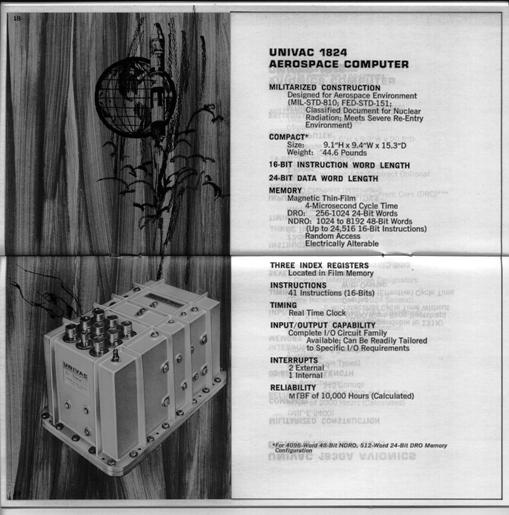
- project start March 1964: Year: 1964 – 1969 Size: 9” x 9” x 15” Weight: 32.15 lbs. Input Power: 24 Volts DC
Instruction Repertoire:
45 unique 16 bit instructions, each comprised of a 5-bit operation
code, a 2-bit index register designator, a one-bit field to indicate
whether the extension (base) register was to be used.
Memory: Thin-film Memory layout: DRO (Destructible
Readout) or RAM 512 - 24 bit words
NDRO (Non-Destructible Readout) Thin-film: Instructions/Constants –
3584 - 48 bit words. Words were addressed as 3 – 16 bit instructions
in width (thus up to 10752 instructions) or as 2 – 24 bit operands
(up to 7168 constants).
The computer program was loaded on the ground during pre-launch activities via punched paper or Mylar tape. Magnetic loading media was not allowed by the Air Force due to what they perceived as the vulnerability of magnetic media. During flight, this on-board computer received vehicle attitude inputs from an inertial Guidance Platform, basically a three-gyro system feeding the computer information from three gimbals angular readout devices.
This data was then processed in the 1824, to determine and output steering commands, guiding the vehicle on a predetermined, parameterized path including roll maneuvers, thruster jettisons, and payload release. [Bill Corson ]
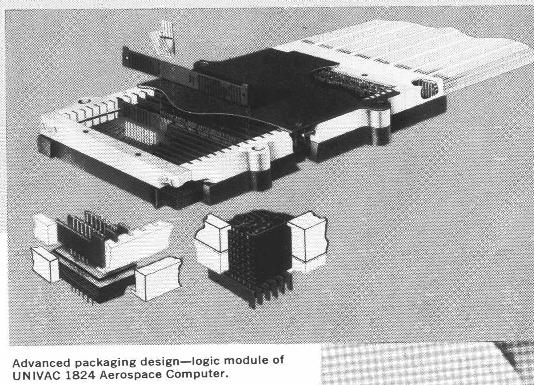 The internal structure of this space-borne computer had many of the
components encapsulated as shown in this drawing provided by Larry Bolton.
The Sabre/1824 was the first Univac defense systems computer to use
monolithic integrated circuits, regardless of package type. Earlier
machines had used discrete semiconductors. These first integrated circuits
used Diode-Transistor-Logic (DTL) and were designed by Univac and implemented
in silicon by Westinghouse.
The internal structure of this space-borne computer had many of the
components encapsulated as shown in this drawing provided by Larry Bolton.
The Sabre/1824 was the first Univac defense systems computer to use
monolithic integrated circuits, regardless of package type. Earlier
machines had used discrete semiconductors. These first integrated circuits
used Diode-Transistor-Logic (DTL) and were designed by Univac and implemented
in silicon by Westinghouse.
The 1824 used flat package integrated circuits. The 1824 (MMRBM) DTL
Monolithic Gates were documented in procurement specs numbering 7900309
through 7900334, and other later numbers. [Larry Bolton]
From Lyle Franklin: In the mid sixties Arne Hendricksen was the leader of the Aerospace Group which included antenna coupler and the aerospace computers. Design Engineering was led by John McDonough and Ted Sammis was lead engineer of the 1824. I reported to Bob Moravec. Bob was in charge of Program Management. Also reporting to Bob was Tom Morris who led the Sabre Group. I was in charge of program planning using PERT. After I arrived John and Ted left for CDC.
To reduce size the 1824 used the multi layer board design. If memory serves me, it was seven layers. As the normal drilling was not accurate for this many layers the boards were first molded with the holes for the later insertion of interconnect pins and then copper coated and etched. Plated memory was in its infancy. Some months there was minimum yield or no usable yield. Also the integrated circuits developed what was termed the "Purple Plague." In those days Univac designed the circuits and the manufacturers implemented the design. The signal strength of 10 volts may have been overdriving the circuits. As a result the leads were shorting internally. Bob Moravec, Don Larsen, and I were part of the team to visit the vender. During our visit we discovered a graphite "boat" was used in the annealing process. Circuits were clipped to the boats for annealing. The clips caused particles of graphite to be included in the final package. The signal strength attracted the particles causing the shorting out. This change solved the problem. As the head manufacturing planner, Bill MacArthur also left for CDC, Arne asked me to lead the detailed manufacturing production planning.
Due to the "Purple Plague" problem engineering developed another
test for the units. The case had fins for cooling. In an attempt to
dislodge the graphite particles, engineering included powering the unit
and then running a tongue depressor back and forth over the sides of
the box. The Air Force inspectors were quite upset with this test as
the tongue depressors were not calibrated.

The 1824 was at the cutting edge of technology which contributed significantly to the schedule and cost problems. Due to the problems, Mr. Probst lost interest in this element of the market.
3.7 CP-818 (1224)
The CP-818A/U computer was the processor for the AN/GYK-9A system.
3.7.1 Comment from Roger C. Morris
I worked on the defense systems test floor [Plant 3] in the mid to late sixties [before that operation was moved to Plant 1 [Shepard Road.] I worked mostly on the 1218 and 1219 computers, but also on the 1224 project at Plant 5, with an engineer named Charles Chu. I can't seem to find any info about the 1224 on this website. Is there anything available? Thanks. Roger C. Morris
3.7.2 Comments from Don Mager
The 1224 was an off-shoot of the 1218 computer we designed for the National Security Agency (NSA). At the time [1964], I reported to Hy Osofsky and I was the 1224 Project Engineer. Leroy Olson designed the I/O section and I designed the CPU and control sections. This computer had a very specialized instruction repertoire. I recall one of the instructions was so complex I actually flow charted it - to make sure it was correct! After delivery of the initial units, I made a couple trips to NSA - very interesting place. I don't recall any "Charles Chu" having anything to do with the 1224 - at least not during the development phase. Nor do I recall a person by that name ever being part of Plant 5 Engineering. Ernie Lantto was not involved with the original development and it was one of the few computers in which Glen K. was not involved. Don Mager
3.7.3 Comment from Lowell Benson
I have a May 1968 genealogy chart that shows the 1224 as the CP-818, a derivative or follow on to the 1218 computer. the link between the two is that some of the same logic card designs were reused.
3.7.4 Comments from Dick Erdrich
I worked on the 1224 program writing acceptance test programs. I don't remember who was actually doing the design work. I believe that it was called the FlexComp and was a 24 bit machine just like the designation 1224 signifies. It featured what amounted to a special purpose register set designated as Talley registers that could be used to correlate data occurrences in a data field. I had a lot of fun writing the test programs for the Talley registers and ended up using a series of index modified nested loops to run all data combinations. If I could ever find my staff data sheet I could probably tell you exactly when I was working on it. I'll have a look. [Dick Erdrich]
3.7.5 Comments from Quint Heckert:
According to the Type Number Mill Nomenclature Listing the following: 1224 is listed as the CP-818/U, a 24 bit Computer, TUGGLE; Part Number 7033059, 4041224; Specification DS-4829. Some people I talked to seemed to remember a TUGGLE Program/Project but nothing more than the name. Quint Heckert {Editor's note: Considering the classified nature of the application(s) it is no suprise that the hardware engineering staff would not be aware of what a few software programmers may have had access to.}
3.7.6 Comments from Ernie Lantto
The 1224 [CP-818] project started in September 1962 with five units
shipped in early 1964. A 1224A [CP818U] project started in October 1964
with deliveries through Oct. 1965.

3.7.7 Comments from: Tony Mannucci via web site, January 30, 2009:
Message: I was in the USAF Security Service back in the late 70's/early
80's. I was a ground radio repairman and had no computer experience,
but the Air Force sent us to the Navy Technical Training Center at Corry
Station in Pensacola, Florida. We attended a 6-month course on the AN/GYK-8
FLEXCOP system which consisted of the Univac 24-bit computer, CP-818
and its peripherals. We were first taught machine-code programming for
the first 6 weeks. The rest of the time was spent on learning the peripherals.
Our training focused on writing our own utilities for troubleshooting
the system. The school was the best I attended in my service career
because one I left the school, I was capable of maintaining the system.
This was the Navy way whereas the Air Force typically used OJT to take
the school knowledge and complete it with hands-on experience.
Long after I completed my Air Force career, I went to work for the Federal
Aviation Administration. I found myself working on the ARTS IIIA Automation
System which to me were very much like the CP-818's I worked on
previously. The training was at the FAA Academy in Oklahoma City. It
was considered a difficult course. I found it seriously lacking because
the course administrators removed the programming from the curriculum
because students had too much difficulty and their grades reflected
it. These computers did not have all the registers like the CP-818 had,
but they were very reliable.

3.7.8 Comments from: Tom Van Keuren
- Senior Principal Engineer Raytheon Company April 1, 2013My first story about the CP-818 computer system is:
I was in the Air Force Security Service in the fall of 1968 when I got the opportunity to be trained on the CP-818 FLEXCOP Ironhorse system at the National Cryptologic School in Maryland. The first thing they did was test us on basic electronics, and after testing they called me into an office and grilled me for a while, because I was the first person ever to get a perfect score. So, instead of the basics class, I got to play with a trainer computer, which I believe was the Univac CP-788 Universal Digital Trainer, because I remember its 15 bits word size. That extended until Christmas that year. Previously at the U of Minnesota I had heard a computer playing a simple tune, so I just had to program the trainer to do that. I got it to play Christmas music down the hallway by connecting an amp and speaker to a register LSB. Unfortunately, its slow instruction cycles limited its tonal scale accuracy to barely an octave.
The CP-818 computer at 24 bits and instructions as fast as 4 usec, plus shift instruction increments of 2/3 usec, meant far more accurate tonal scale accuracy for my later music program. In fact, it could provide 5.3 octaves range with accuracy within 1% at the highest note (even-tempered musical scale notes are about 5.9% apart).
Our computer class had one CP-818 about the size of a refrigerator. It was built for very rapid troubleshooting with most logic nodes available on a test panel. We could trace faults very quickly by poking one after the other through the schematics. The front panel with its indicator switches made it very easy to read register values and also to poke values and short test programs into the machine. One exercise we had was to write the shortest "inspect and change" program we could into it, which became the basis of many later test routines we saved on paper tape. There were other peripherals in the system, but, of course, the computer was the most fascinating part of it. I used to spend many hours after class working with the computer. One night as I was leaving, the security guards pulled their guns on me because they were unaware I was still in the compound. I wrote the obligatory Tic-Tac-Toe program for the computer and graphic display unit (a CRT in portrait orientation). I condensed the lookup of moves by rotations and flips so it was compact, and I think there were only 18 unique combinations as a result. The player went first and the computer responded, delaying with a message "I'm thinking." Consequently nobody kept playing it because the computer could not be beaten.

3.7.9 Comments from: Tom Van Keuren - Senior Principal Engineer Raytheon Company, April 12, 2013
The system was at the 6924th Security Squadron in Da Nang, Viet Nam.
When I arrived in Da Nang, Viet Nam in July 1970 my assignment was maintaining
the Ironhorse system that consisted of two CP-818 computers, two CRT
display units, six magnetic tape drives and the controller, a drum line
printer, and a paper tape reader/punch. There were also two operator
consoles that we had not been trained on back in Maryland, but they
never seemed to need any repairs.
The computers came with diagnostic software that was quite exhaustive
in its coverage of the logic, but not very adaptable to examination
of specific circuitry and functions. So I wrote quite a few short routines
for specific tests and saved them on paper tape, which was much easier
to load than mag tape. It included tests for the CRT displays and the
line printer.
The line printer drum only had capital alpha characters on it, besides
numbers and symbols, no lower case alphas, which was annoying when I
wanted to print out a page that looked like a typewriter document. Furthermore,
the characters on each line were vertically staggered because the timing
of the hammers was never consistent even though we would adjust them
repeatedly. Good enough for government work. I wrote a simple editing
program on the CRT display that would print out on the line printer
when ready. The worst line printer problem we had was when the paper
would not advance because the stepper circuitry got confused by a loose
belt.
Most of the computer problems were fixed very rapidly because of the
handy test panel that allowed us to isolate logic problems quickly.
We never had a core memory read or write problem with the drive or sense
circuitry, which was fortunate. But the worst problem with the computer
was a dozy. At first a parity error would occur about once every few
days. Then it worsened to several times a day. Of course, when we jumped
on it and ran diagnostics, everything was fine. We were getting flak
for the system going down repeatedly and affecting our mission. We tried
replacing circuit cards various places, but we were shooting in the
dark. It wasn't until the problem got so bad that it was occurring
every few seconds that we were able to catch it with diagnostics. I
modified the software to loop with the front panel lights showing different
patterns for pass and fail, then we were able to trace the problem to
a reset buffer that was passing noise glitches as its threshold decayed
over time.
The magnetic tape drive problems were all related to worn tape heads
- and to bureaucracy. Several drives were experiencing parity errors
and we replaced the head assembly with spares until we had no more.
We ordered new head assemblies, and in the meantime swapped head positions
between drives to continue operations. But my request for new head assemblies
was denied because they were "high value items." So we got
our boss to write a letter of justification and resubmit, but it was
denied because they were "really high value items." So we
got our squadron commander to sign and resubmit, but still not good
enough for the supply chain. By this time our operations was affected
and word got back to NSA that we needed help fixing our computer system.
So NSA sent out from Maryland all the way to Da Nang a civilian technician
to solve our problems. I told him we needed new tape head assemblies
and showed him the waveforms. He spent several days doing his own probing,
then he wrote up his recommendation that we needed new tape head assemblies!
Soon thereafter we got them, and our system went back to normal. Our
commander recommended a special award for the NSA tech!

3.7.10 Comments from Les Fairall:
I stumbled onto https://www.vipclubmn.org while trying to find anything I could on old systems which I had operated in my early days. AND I found this page with the CP-818 on it... I couldn't believe it!
I used to run jobs on this machine back in 1979 [it was still in heavy use then at Fort Meade in our computer room.] I don't recall details, but I remember the 400hz dynamotor down the hall that converted 60hz to 400hz to run this beastie. We had probably 6 tape drives [stacked 2 per rack.] Man they used to clack! We also had a 5 level paper tape reader/punch. The most modern thing was a TI silent 700 typewriter/keyboard adapted to talk to it. Anyway, not sure if any of this makes sense, but if you know someone that would appreciate this, please pass my thanks along for preserving some important history.
Thanks Again! Les Fairall - Davidsonville, Maryland

3.8 CP-823/U
See the 30 bit computer page.
3.9 Speed Tally, etc.
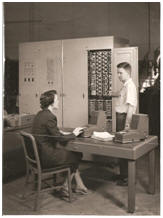
Don Weidenbach is shown in the photo at the right. This 1951 Speed
Tally morphed into the 1953 Logistics Computer which preceded the 1956
File Computer.
We built 95 FILE computers – used for Airline Reservation
Systems and for catalogue ordering systems.
4. Repertoire Cards
Many of our retirees donated repertoire cards to the Legacy Committee. Keith Myhre scanned and catalogued these at the Lawshe Memorial Museum. The 1st copy was donated to the Charles Babbage Institute, a second copy of many was kept at the museum.
- Transtec II and Magstec II Repertoire of Instructions with Flexowriter codes.
- UNIVAC 1224 A Repertoire of Instructions.
- UNIVAC 1824 Airborne Digital Computer Instruction Repertoire.
- UNIVAC 1824 Computer Instruction Repertoire.
5. Technical Manuals
The bit-savers web site (http://bitsavers.informatik.uni-stuttgart.de/) has over 32,000 documents. We've copied the 24-bit ISA documents and linked them hereunder for technology researchers ease of access.
- CONUS 24 Digital Computer Description (Model 9100)
- CONUS 9100 Digital Computer Management Planning
- CP-818A/U Digital Data Computer
- UNIVAC File-Computer System Specification
- UNIVAC File-Computer Data Automation System
- SPTM4287 UNIVAC File-Computer Operating Principles
- EF328 Univac File Computer System Resume
- BOGART Programmers Manual
- Tentative 9140 Digital Computer description, September 1974.
- Autodin Communications proposal, September 1974.
In this Chapter
- Introduction [left]
- Genealogy Chart
- Computer unit summaries: Classified, Atlas, 1101, 1102, Athena, 1824, 1224 (CP-818), CP-823, Speed Tally, et al',
- Repertoire Cards
- Technical Manuals
Chapter 51 edited 9/30/2025